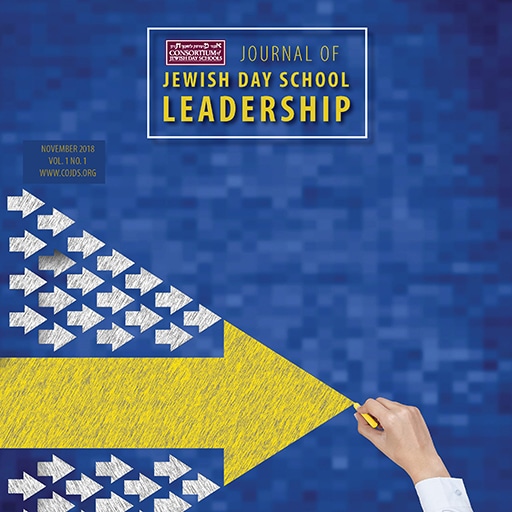
Seeking Submissions
January 3, 2022
CoJDS’ Curriculum Development–A Closer Look
January 17, 2022by Rabbi Dov Chastain
I am always excited by the chance to get my hands on new Judaic studies curriculum and have become very much a curriculum collector or pack rat, but finding a comprehensive list of Judaic studies benchmarks and standards can be difficult, even for the most prolific of curriculum pack rats. In addition, it is very difficult to create a “one-size-fits-all” Judaic studies curriculum, as every school has a unique character, clientele, and culture.
During the 2017-18 school year, our administrative team had several meetings to evaluate the best practices for our Judaic studies curriculum. We had a team of incredibly talented limudei kodesh teachers with a variety of strengths and teaching styles. We were searching for a way to build continuity within our curriculum, without stymieing the originality and creativity of our talented staff. We also wanted to ensure that the final product of our curricular journey would be something that our teachers would be proud of and would be highly invested in. We came up with an interesting solution, which I would like to share with you, as it can be duplicated and lead to an amazing collaborative project.
One of my professors at Loyola University, Dr. Marla Israel, explained that when examining changes to school culture, one must “begin with the end in mind.” One has to ask themselves, “What are the desired goals of the changes one plans to make in their school?”
With that in mind, our administrative team developed the following goals for our project:
- 1. To create a comprehensive Judaic academic skills scope and sequence, and an outline of curriculum and benchmarks.
- 2. To build a culture of enthusiastic and motivated teachers who are very dedicated to the Judaic studies program.
- 3. To make sure not to handicap teachers, but to help develop final goals for the specific skills and knowledge their students will leave their classes with and allow them to use their creativity to reach them.
- 4. The ultimate goal was, and always is, to ensure that we are offering our students the best education possible, and studies have shown time and time again that collaborative practices build teacher buy-in, and teacher buy-in directly positively influences student outcomes tremendously (Yoon, 2016).
We took our goals and decided to plan a creative workshop for our entire Judaic studies staff during our spring professional development day. We started off by gathering everyone in the teacher’s lounge for a team meeting to lay out our plan. We were to create a giant, physical, school curriculum “scroll,” with sections on the scroll for each of our grade levels, and arrows indicating progression of skills from each grade to the next.
For each grade level, we created four subsections:
- 1. Entry Expectations
- 2. Core Skills and Material/Content Covered
- 3. Textbooks and Materials
- 4. Exit Expectations
We began the meeting by explaining the project and its goals to the staff and told everyone that we would be giving them the first two hours of the morning to go to their classrooms and brainstorm, review their curricular materials, and then write down their entry expectations, core skills and material/content covered, textbooks and materials, and exit expectations for each of the grade levels they teach.
We broke for the morning, and as our teachers returned to their classrooms, our administrators headed down to an empty classroom in our wing to begin crafting our great Judaic curriculum “scroll.” We took a roll of white poster-board and covered an entire 30-foot wall with poster-board. We used sharpies and straight edge yardsticks to create sections for each of our grade levels and wrote in the four subsections for each grade level.
After a catered staff lunch in the teacher’s lounge, we brought all our teachers down to the classroom containing our scroll and asked each teacher to use sharpies to fill in the scroll with the information they had compiled about their entry expectations, curricular goals, textbooks, and exit expectations. With the entire scroll created, we all reviewed it together from kindergarten through 8th grade. We drew arrows from the exit expectations of each class to the entry expectations of the next to compare them, and we correspondingly added to some and subtracted from others to ensure we created a realistic picture. We combed the entire scroll through for consistency and continuity, we made sure our goals were aligned, we discussed the best textbooks to use, and over the next hour and a half, we really came together with united goals and a united view of what we wanted to accomplish with our students, as well as a plan for how we were going to accomplish them. Seeing it all before us in one continuous flow made it so much easier to visualize our goals.
We finished the day with a discussion about how we were going to use this scroll to create a comprehensive Judaic academic skills scope and sequence, and an outline of curriculum and benchmarks. We reiterated our dedication to enabling our teachers with the tools they need to succeed, but not inhibiting their creative talents. This concluded the professional development day, but it was only the beginning of the journey.
Though that professional development seminar would have been a very productive exercise had it ended with the scroll, as we all know, follow-up is key. We wanted to give our teachers a reference they could easily use in their classrooms and wanted to have individual meetings with them to follow up on implementation of our newly cemented curricular goals. During that spring and summer, our administrative staff took on the task of transcribing that scroll into a comprehensive digital document. We consulted several additional curricular resources in finalizing the document, including the L’havin U’Lehaskil list of chumash and dikduk skills, Rabbi Shmuel Jablon’s “Curriculum in Judaic and Hebrew Studies” from the Torah Academy of Philadelphia, Mrs. Aviel Brodkin’s “Judaic Studies Outline for Curriculum & Benchmarks” from Ma’ayan Torah Day School of Portland, the list of skills from the Yesodot Ha’Lashon series of Hebrew language books, and many other textbooks. Once we had a final edited document, we scheduled meetings with each of our teachers to review it and brainstorm the best practices for implementing it.
Ever since that summer, we begin the school year with discussions with each of our Judaic studies teachers centered around how we plan to reach the benchmarks and standards laid out in the curriculum document. We also end each school year with a meeting to review the challenges and triumphs of that year’s class and discuss what needs to be added or subtracted from the curriculum.
I am happy to report that this entire project really infused new life into our Judaic curriculum. It was amazing to see how much effort our teachers put into making that scroll, and how dedicated they have been to its contents, and much of it was due to the collaborative nature of the project. They saw we valued their opinions, and it truly boosted their dedication to the goals, and their own connection to, and passion for, our curriculum.
After discussing this project with Rabbi Hillel Adler of CoJDS, he confirmed that a comprehensive Judaic studies scope and sequence with benchmarks and standards is indeed hard to come by, and that it would be nice if schools did not have to start from ground zero in creating such a thing. We are happy to share the document that we have created with anyone who would like to use it as a resource. Please feel free to request it via email from [email protected].
References: Yoon, S.Y. (2016). Principals’ Data-Driven Practice and Its Influences on Teacher Buy-in and Student Achievement in Comprehensive School Reform Models. Leadership and Policy in Schools, 15(4), 500–523. https://www.tandfonline.com/doi/abs/10.1080/15700763.2016.1181187
Rabbi Dov Chastain has served on the Judaic studies faculty of Derech HaTorah in Rochester, NY, since 2017 and has become the assistant principal while still teaching Judaic studies. He formerly taught at Maayan HaTorah in Portland, OR. Rabbi Chastain welcomes feedback at [email protected].

